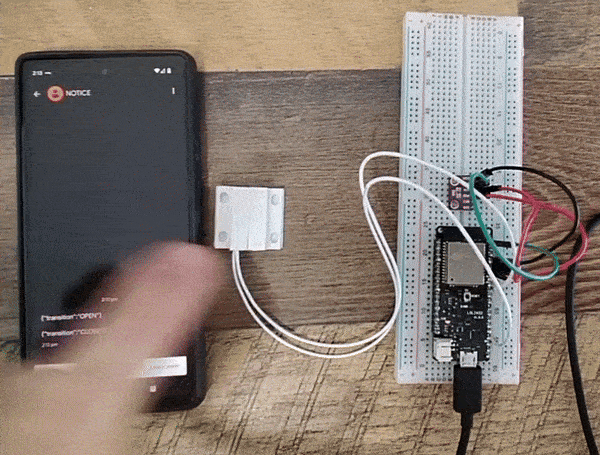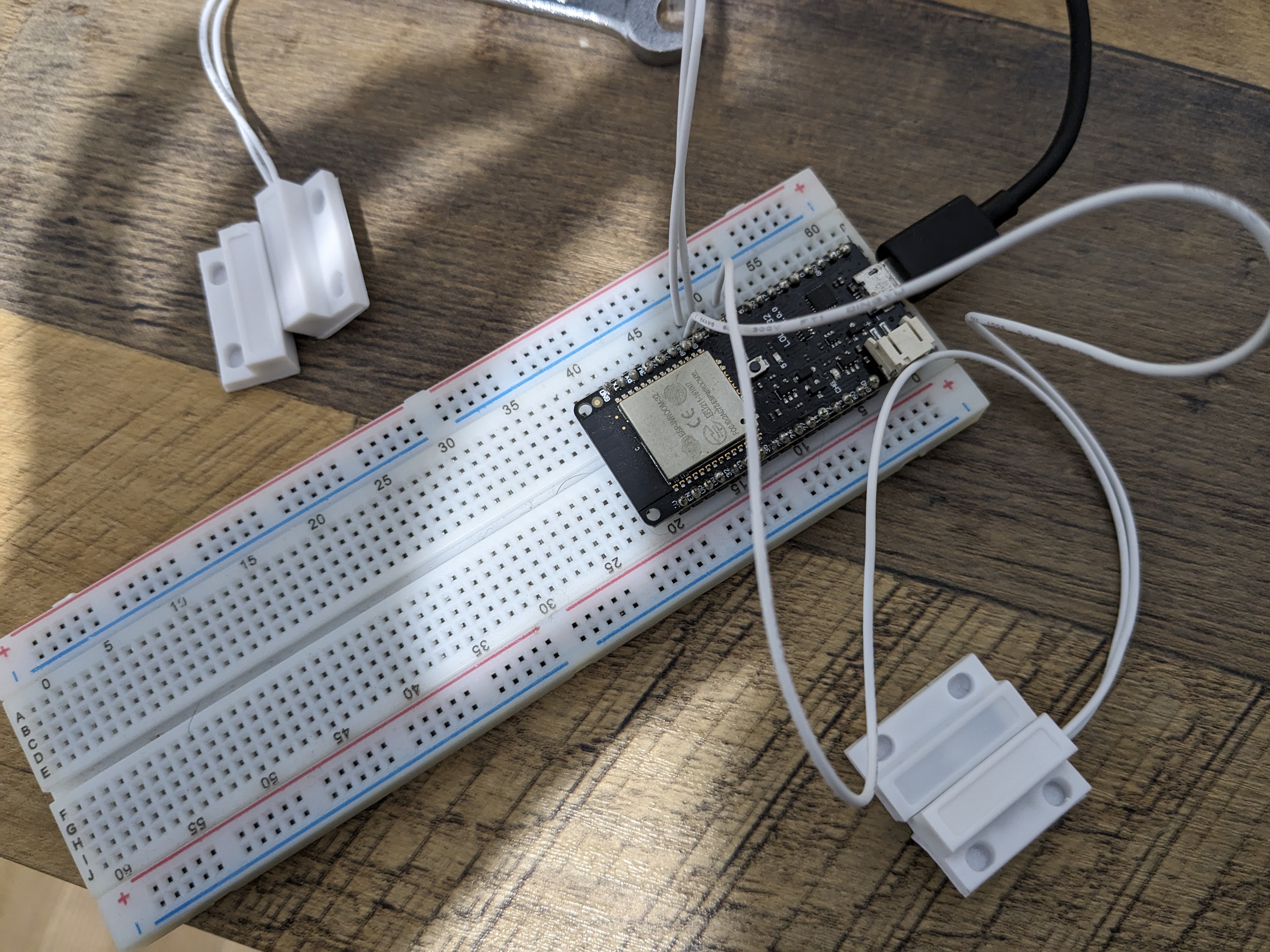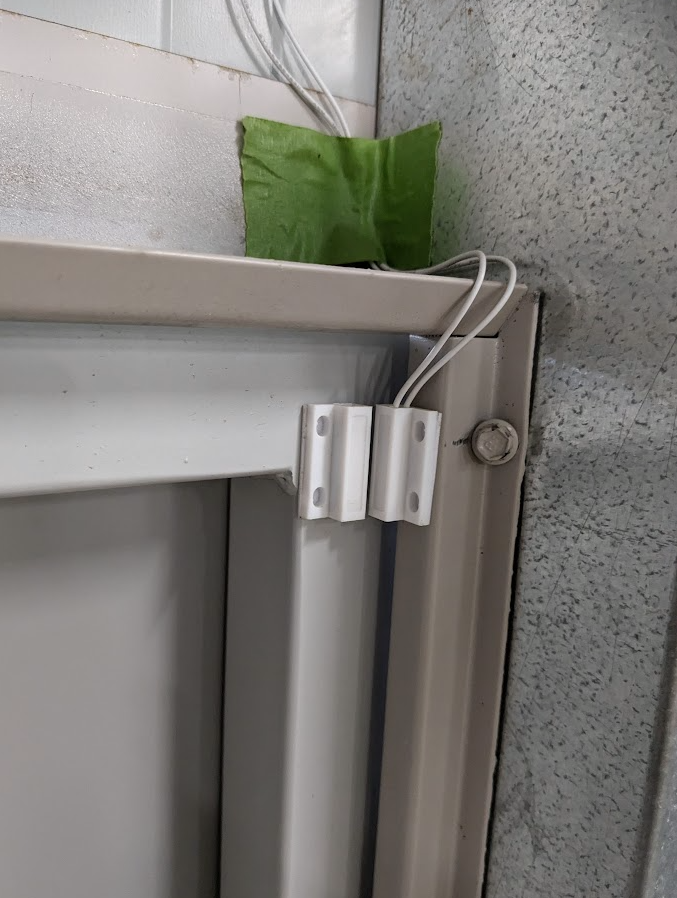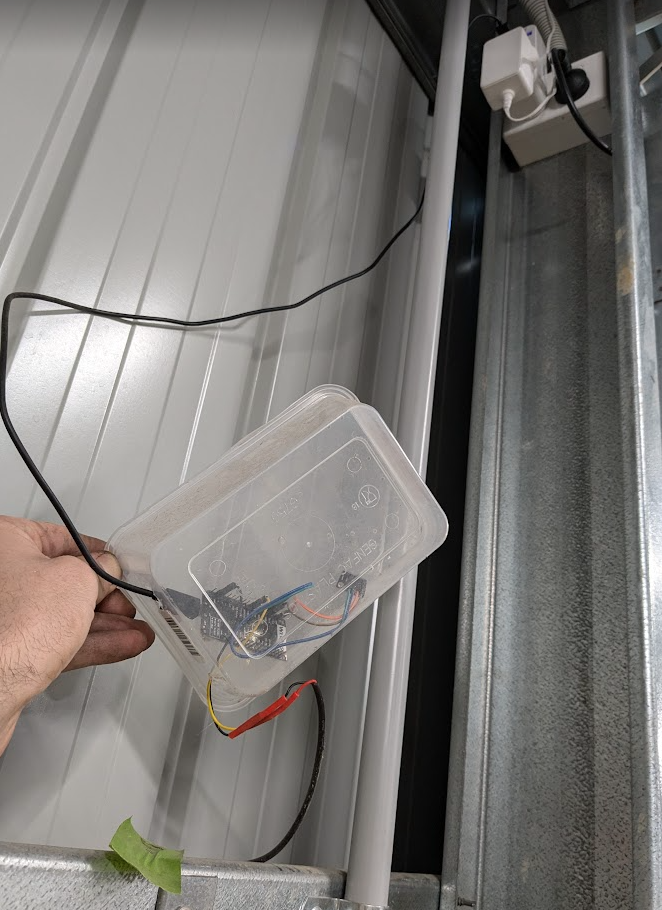Building a cheap door alarm with an ESP32 and AWS IoT
A few years ago I had a shed built on my property, well perhaps a barn is a better description. Whilst I live in a good area, I’m always concious of security and decided to build a solution to notify me if the doors are opened. I could have bought an off the shelf solution, but where’s the fun in that!

At a glance
The esp32 is the brains of the system, it’s connected to a reed switch that will be triggered when the door opens or closes, which then sends a message to AWS IoT via MQTT. I have some rules configured in AWS IoT that forward the message on to a time series DB so I can plot the opening/closing in Grafana, but the rule also forwards to SNS so my phone will be alerted if the door opens. After a while I did replace the SNS rule with a Lambda that posts to my discord server instead, because SMS becomes expensive, at least in terms of hobby projects.
Hardware
The parts I used:
- ESP32
- Pack of reed switches
- Breadboard
- Jumper wires
- Extra length of wire because the sensor was a long way from the ESP32
- An old plastic tub to house it, in my case, a cleaned out food container, but a butter/yoghurt tub would work too.
The wiring was very simple, the reed switch has two wires, one goes to ground and the other to a GPIO pin on the ESP32, I used GPIO 23. The reed switch is normally open, so when the magnet is close, the circuit is closed and the GPIO pin goes high.

Installation was also easy, I just used some double sided tape to stick the reed switch to the door frame and the magnet to the door, I had to use a bit of extra wire to reach the ESP32, but it was easy to hide behind the framing of the shed.


Software
The software is also rather straightforward, but do note that I also had a BMP280 sensor connected to the ESP32, so you’ll see some references to that in the code. I was using this board for both the door sensor and temperature sensor.
#include <Wire.h>
#include <Adafruit_Sensor.h>
#include <Adafruit_BMP280.h>
#include "utils.h"
// Pin wiring:
// VCC -- 3v
// GND -- GND
// SCL -- 22
// SDA -- 21
#define SEALEVELPRESSURE_HPA (961.77) // Replace with the actual sea level pressure for your area
Adafruit_BMP280 bmp; // I2C
unsigned long lastHeartbeat = 0;
unsigned long lastTemperatureReading = 0;
const int heartbeatInterval = 60000; // Heartbeat interval in milliseconds
const int temperatureReadingInterval = 60000; // Temperature reading interval in milliseconds
const int reedSwitchPin1 = 19; // Define the digital pin connected to the reed switch
int reedSwitch1State = 0;
const String doorName = "pa-door";
void setup() {
Serial.begin(9600);
if (!bmp.begin(0x76)) {
Serial.println("Could not find a valid BMP280 sensor, check wiring!");
while (1);
}
pinMode(reedSwitchPin1, INPUT_PULLUP); // Set the reed switch pin as an input with internal pull-up resistor
reedSwitch1State = digitalRead(reedSwitchPin1); // set the initial state of the reed switch
connectAWS();
}
void loop() {
// check reed switch
int reedSwitchState1Loop = digitalRead(reedSwitchPin1); // Read the state of the reed switch
// if the door was closed, but now opened
if (reedSwitch1State == LOW && reedSwitchState1Loop == HIGH){
Serial.println("Door opened");
publishDoorTransition(doorName, "OPEN");
reedSwitch1State = reedSwitchState1Loop;
}
else if (reedSwitch1State == HIGH && reedSwitchState1Loop == LOW) {
Serial.println("Door closed");
publishDoorTransition(doorName, "CLOSE");
reedSwitch1State = reedSwitchState1Loop;
}
// Send heartbeat every 5 seconds
if (millis() - lastHeartbeat > heartbeatInterval) {
publishHeartbeat();
lastHeartbeat = millis();
}
// Take temperature reading every 30 seconds
if (millis() - lastTemperatureReading > temperatureReadingInterval) {
Serial.println("Reading BMP280...");
float temperature = bmp.readTemperature();
float pressure = bmp.readPressure() / 100.0F;
Serial.print("Temperature = ");
Serial.print(temperature);
Serial.println(" *C");
Serial.print("Pressure = ");
Serial.print(pressure);
Serial.println(" hPa");
float altitude = bmp.readAltitude(SEALEVELPRESSURE_HPA);
Serial.print("Approx. Altitude = ");
Serial.print(altitude);
Serial.println(" m");
Serial.println();
publishMessage(temperature, pressure);
lastTemperatureReading = millis();
}
// Handle MQTT events
if (!client.connected()) {
connectAWS();
}
client.loop();
}
I also moved some code over to a utils.h file that handles the connectivity to AWS
#include <Arduino_BuiltIn.h>
#include "certs.h"
#include <WiFiClientSecure.h>
#include <PubSubClient.h>
#include <ArduinoJson.h>
#include "WiFi.h"
#define AWS_IOT_PUBLISH_TOPIC "env-sensor"
#define AWS_IOT_PUBLISH_HEARTBEAT_TOPIC "heartbeat"
#define AWS_IOT_PUBLISH_DOOR_TOPIC "door"
#define AWS_IOT_SUBSCRIBE_TOPIC "env-sensor-back-deck/sub"
WiFiClientSecure net = WiFiClientSecure();
PubSubClient client(net);
void messageHandler(char* topic, byte* payload, unsigned int length) {
Serial.print("incoming: ");
Serial.println(topic);
StaticJsonDocument<200> doc;
deserializeJson(doc, payload);
const char* message = doc["message"];
Serial.println(message);
}
void connectAWS() {
WiFi.mode(WIFI_STA);
WiFi.begin(WIFI_SSID, WIFI_PASSWORD);
Serial.println("Connecting to Wi-Fi");
while (WiFi.status() != WL_CONNECTED){
delay(500);
Serial.print(".");
}
Serial.println("Connected to Wi-Fi");
// Configure WiFiClientSecure to use the AWS IoT device credentials
net.setCACert(AWS_CERT_CA);
net.setCertificate(AWS_CERT_CRT);
net.setPrivateKey(AWS_CERT_PRIVATE);
// Connect to the MQTT broker on the AWS endpoint we defined earlier
client.setServer(AWS_IOT_ENDPOINT, 8883);
// Create a message handler
client.setCallback(messageHandler);
Serial.println("Connecting to AWS IOT");
while (!client.connect(THINGNAME)) {
Serial.print(".");
Serial.print(client.state());
delay(100);
}
Serial.println("Connected to AWS IOT");
if (!client.connected()) {
Serial.println("AWS IoT Timeout!");
return;
}
client.subscribe(AWS_IOT_SUBSCRIBE_TOPIC);
Serial.println("AWS IoT Connected!");
}
void publishMessage(float temperature, float pressure) {
StaticJsonDocument<200> doc;
doc["temperature"] = temperature;
doc["pressure"] = pressure;
doc["device_name"] = THINGNAME;
char jsonBuffer[512];
serializeJson(doc, jsonBuffer);
client.publish(AWS_IOT_PUBLISH_TOPIC, jsonBuffer);
}
void publishHeartbeat() {
StaticJsonDocument<200> doc;
doc["heartbeat"] = 1;
doc["device_name"] = THINGNAME;
char jsonBuffer[512];
serializeJson(doc, jsonBuffer);
client.publish(AWS_IOT_PUBLISH_HEARTBEAT_TOPIC, jsonBuffer);
}
void publishDoorTransition(String door, String transition) {
StaticJsonDocument<200> doc;
doc["door"] = door;
doc["transition"] = transition;
doc["device_name"] = THINGNAME;
char jsonBuffer[512];
serializeJson(doc, jsonBuffer);
client.publish(AWS_IOT_PUBLISH_DOOR_TOPIC, jsonBuffer);
}
You can find the full code for this, and some of my other ESP32 / home automation projects here
